
Grenen is a long sandbar spit at Skagen Odde (the headland of Jutland), north of the town of Skagen.
Contents



Grenen is a long sandbar spit at Skagen Odde (the headland of Jutland), north of the town of Skagen.


Grenen (The Branch) was named for its shape like a tree-branch, reaching out from the mainland. The beach of Grenen appears in many of the works of the Skagen Painters, a community that gathered there every summer between 1875 and the end of the 19th century. The area is also home to the Skagen Odde Nature Centre, designed by Jørn Utzon.
Near the tip of the spit are two small museums: Skagen Bunker Museum and Grenens Kunstmuseum. Danish national road 40 terminates at Grenen, and it is one of the most popular tourist destinations in the country, with approximately 2 million visitors each year.
Grenen marks the junction between the strait of Skagerrak (part of the North Sea) and the Kattegat sea, and the turbulent colliding seas have created a 4-km long curved sandbar above and below the waves stretching east. The reef is still active and has grown about 1 km northeast towards Sweden over the last century, resulting in a mean annual growth rate of about 10 m. Because of the very strong currents, swimming there can be fatal and is prohibited in the waters around Grenen.
The area surrounding Grenen is the place with the greatest number of observed bird species in all of Denmark. [1] Birdwatchers regard it as the best spot in Northern Europe, for observing birds of prey during their spring migrations. [2] Birds often gather here before crossing the seas to Bohuslän in Sweden. There are more migratory birds near Grenen when the wind is from the south-east. If the wind is from the south-west, many birds choose a route across Funen and Zealand instead. The annual Skagen Birding Festival has been celebrated here since 2005, attracting more than a thousand visitors and participants. [3]
Grenen is also one of the best places in Denmark to observe sea mammals. Porpoises and common seals are very common here, and grey seals can be spotted here year round as well. As the area attracts many birdwatchers with binoculars, Grenen has also offered many whale sightings. The species most often reported are dolphins (especially white-beaked dolphins), northern minke whale and orcas. There have been isolated reports from Grenen of more exotic animals such as the walrus, the hooded seal and others. [4]
Scientists view Grenen as a laboratory on both land formation and botany, as new land is continuously being formed and shaped here, soon to be colonized by pioneering flora.[ according to whom? ]
Sailors long feared Grenen, as many ships have run aground on the shallow reef through history. The first light signals were erected in 1561 on orders from King Frederik II after international pressure. It was not very effective and was not regularly attended, so from 1627 Skagen's Vippefyr, a coal- and wood-fired tipping lantern, replaced it until 1747, when Skagen's White Lighthouse was built. The 44-metre high Skagen's Grey Lighthouse has done the job since 1858, and in 1956 the 26-metre tall Skagen's West Lighthouse was added, making the heavy traffic in and out of Kattegat adequately safe.[ citation needed ]
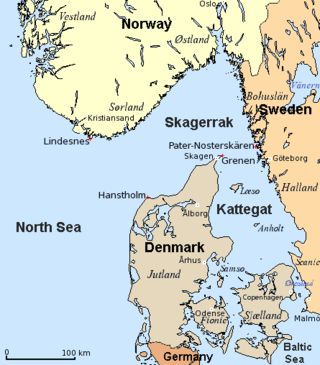
The Kattegat is a 30,000 km2 (12,000 sq mi) sea area bounded by the Jutlandic peninsula in the west, the Danish Straits islands of Denmark and the Baltic Sea to the south and the provinces of Bohuslän, Västergötland, Halland and Skåne in Sweden in the east. The Baltic Sea drains into the Kattegat through the Danish Straits. The sea area is a continuation of the Skagerrak and may be seen as a bay of the North Sea, but in traditional Scandinavian usage, this is not the case.

Samsø is a Danish island in the Kattegat 15 kilometers (9.3 mi) off the Jutland Peninsula. Samsø is located in Samsø municipality. The community has 3,724 inhabitants (2017) called Samsings and is 114 km² in area. Due to its central location, the island was used during the Viking Age as a meeting place. The etymology of the island's name is unknown.

Skagen is Denmark's northernmost town, on the east coast of the Skagen Odde peninsula in the far north of Jutland, part of Frederikshavn Municipality in Nordjylland, 41 kilometres (25 mi) north of Frederikshavn and 108 kilometres (67 mi) northeast of Aalborg. The Port of Skagen is Denmark's main fishing port and it also has a thriving tourist industry, attracting 2 million people annually.

The Skagerrak is a strait running between the Jutland peninsula of Denmark, the southeast coast of Norway and the west coast of Sweden, connecting the North Sea and the Kattegat sea area through the Danish Straits to the Baltic Sea.

Port Phillip or Port Phillip Bay is a horsehead-shaped enclosed bay on the central coast of southern Victoria, Australia. The bay opens into the Bass Strait via a short, narrow channel known as The Rip, and is completely surrounded by localities of Victoria's two largest cities — metropolitan Greater Melbourne in the bay's main eastern portion north of the Mornington Peninsula, and the city of Greater Geelong in the much smaller western portion north of the Bellarine Peninsula. Geographically, the bay covers 1,930 km2 (750 sq mi) and the shore stretches roughly 264 km (164 mi), with the volume of water around 25 km3 (6.0 cu mi). Most of the bay is navigable, although it is extremely shallow for its size — the deepest portion is only 24 m (79 ft) and half the bay is shallower than 8 m (26 ft). Its waters and coast are home to seals, whales, dolphins, corals and many kinds of seabirds and migratory waders.

Anholt is a Danish island in the Kattegat, midway between Jutland and Sweden at the entrance to the North Sea in Northern Europe. There are 150 permanent residents as of 1 January 2022. Anholt is seven mi (11 km) long and about four mi (6.4 km) wide at its widest, and covers an area of 21.75 km2 (8.40 sq mi). Anholt is part of Norddjurs Municipality in Region Midtjylland. Before the 2007 municipal reform, it was in Grenå Municipality.
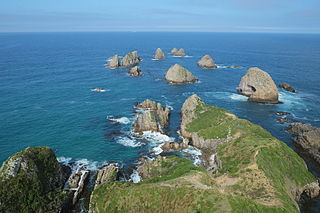
Nugget Point is one of the most iconic landforms on the Otago coast. Located at the northern end of the Catlins coast, along the road from Kaka Point, this steep headland has a lighthouse at its tip, surrounded by rocky islets. The point is home to many seabirds, including penguins, gannets and royal spoonbills, and a large breeding colony of fur seals. Roaring Bay, on the south coast of the tip of Nugget Point, is home to a small colony of yellow-eyed penguins.

Chanonry Point lies at the end of Chanonry Ness, a spit of land extending into the Moray Firth between Fortrose and Rosemarkie on the Black Isle, Scotland.

Sjællands Odde is a 15-kilometre-long (9.3 mi) peninsula on the northwest coast of Zealand between the Kattegat and Sejerø Bay. From the outermost point of the peninsula, Gniben, a reef juts some 10 kilometres (6.2 mi) out into the Kattegat.

The Skagen Odde Nature Centre, on the northern tip of Denmark's Jutland, is a museum devoted to the effects of sand, water, wind and light. It was designed in 1989 by Jørn Utzon, the celebrated architect behind the Sydney Opera House. Under the leadership of his son Jan, the centre was completed in 2000.
Cardigan Bay Special Area of Conservation (SAC), in Cardigan Bay, West Wales, UK, has been designated under European Union law to protect a variety of important species and habitats.
A graded shoreline is a stage in the cycle of coastal development characterised by a flat and straight coastline. It is formed under the influence of wind and water from the original bays, islands, peninsulas and promontories. Sand and gravel is carried away and dumped at other locations depending on the direction and strength of sea currents. Typical of graded shorelines are the formation of dunes, wide sandy beaches and sometimes a lagoon or a spit. Where two graded shorelines meet, a headland may form with a sandy reef in the sea beyond it. Parallel to the graded shoreline sandbanks may form as a result of sediments transported away from the shore.

Skagen Odde, also Skagens Odde, sometimes known in English as the Scaw Spit or The Skaw, is a sandy peninsula which stretches some 30 km (19 mi) northeast and comprises the northernmost area of Vendsyssel in Jutland, Denmark.

Højen or Gammel Skagen on the west side of Skagen Odde is an old fishing community which now forms part of the town of Skagen in the far north of Jutland, Denmark.

Hulsig is a settlement and area of moorland and grey sand dunes in the Råbjerg Mile of the Skagens Odde peninsula, in northern Jutland, northern Denmark. The village lies along the Danish national road 40, to the southwest of the town of Skagen. The rugged heath area is protected under the title Hulsig Heath. Hulsig Station and Hulsig Church are located in the area. Hulsig is home to one of the country's few remaining flocks of dune sheep.
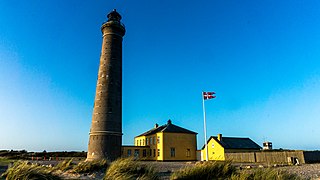
Skagen Lighthouse, also known as Skagen's Grey Lighthouse, is an active lighthouse 4 km (2.5 mi) northeast of Skagen in the far north of Jutland, Denmark. Designed by architect Niels Sigfred Nebelong, it was brought into operation on 1 November 1858.
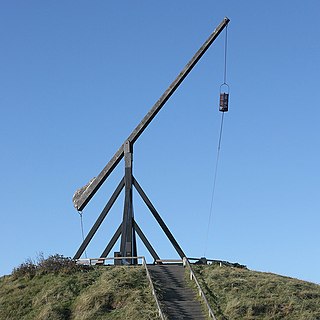
Skagen's Vippefyr is a navigational light mechanism located in Skagen in the far north of Jutland. The original vippefyr, the first of its kind, was built in 1627. A faithful copy now stands on the same site. It replaced an earlier parrot light (papegøjefyr) and served until 1747 when the White Lighthouse was brought into operation.
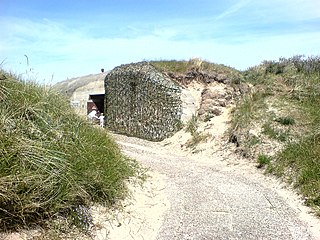
Skagen Bunker Museum is a private museum near the tip of Grenen in the far north of Jutland, Denmark. It is located in an old German bunker of the Regelbau 638 type which was used during the Second World War as an infirmary for treating wounded soldiers. It is now fitted out as a small museum with uniforms, weapons and other artifacts.

Will He Round the Point? is an 1880 oil-on-canvas painting by Michael Ancher, a Danish painter associated with the Skagen Painters. The painting is particularly notable as Ancher sold it to Christian IX of Denmark, bringing Skagen and its artistic community to wider attention.

The North Sea in Stormy Weather. After Sunset. Højen is a 1909 painting by Laurits Tuxen. Although his paintings of Skagen date from the beginning of the 20th century, Tuxen is now considered to be one of artists known as the Skagen Painters who gathered in very north of Denmark in the 1870s and 1880s.
![]() Media related to Grenen at Wikimedia Commons
Media related to Grenen at Wikimedia Commons